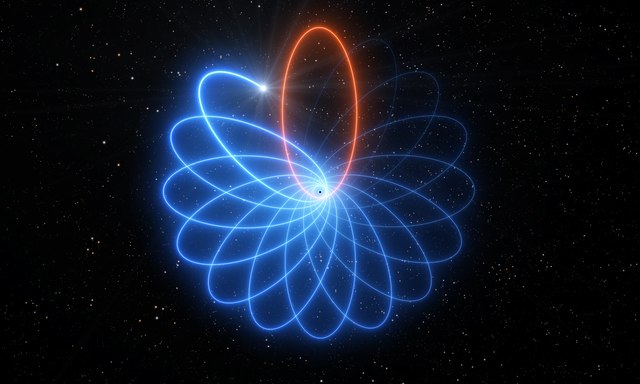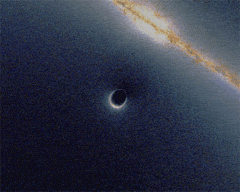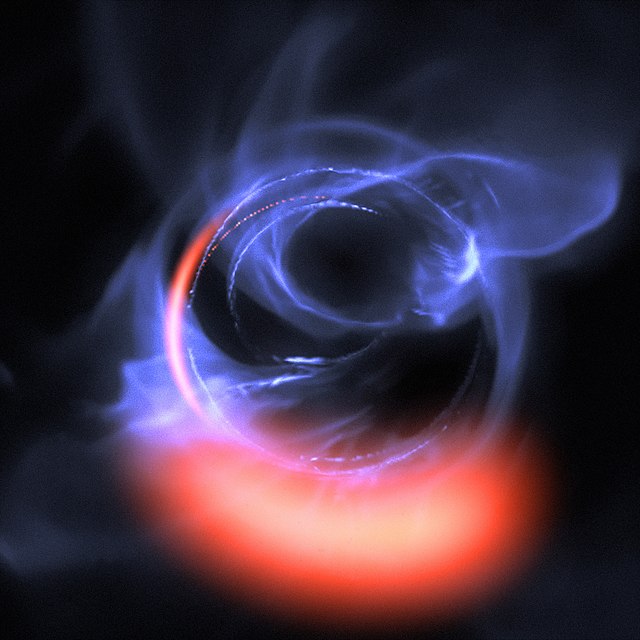As part of the most extreme phenomena in the universe, black hole crashes evident in deep space as two massive, invisible bodies spiral toward each other has left scientists puzzled and pondering about the phenomenon.
During black hole collisions, they disturb the fabric of spacetime and send out gravitational waves across the universe which eventually wash over the earth being heard by some very sensitive detectors in the US, Italy and Japan.
In the early hours of January 29, 2020, the Laser Interferometer Gravitational-Wave Observatory (LIGO) and dual detectors of in the US sensed a similar ripple washes over the earth. A third in Virgo, Italy also picked it up.
The detectors’ characteristic chirp indicated a pair of black holes, one around 40 times the mass of the sun and the other 22 times, had collided.
GW200129 Black Hole collision Wave presented a peculiar signal

In a new study of the wave detected by the chirp from the collision of the pair of black holes, which scientists nicknamed GW200129 when researchers examined it after discovery, it portrayed a peculiar signal.

The wave’s characteristic chirp appeared to suggest the black holes that crashed into each other were “wobbling” around in their orbit in a process scientists call “precession”. On Wednesday, the study was published in the journal Nature indicating that it would be the first time this effect in black holes was seen.
The assumptions from the study left other gravitational wave scientists uncertain if the signal provided proof of this phenomenon however. There was also the possibility that a glitch in one of the gravitational wave detectors that first spotted GW200129 may have affected the data.
Understanding GW200129, Black Hole space collision wave

To critically understand the GW200129 wave the concept of precession, or the aspect of black holes “wobbling” around in their orbit described, requires more clarity.
In order to fully visualize, think of the Earth orbiting the sun and imagine our tiny, blue-green planet rotating around the big, hot ball of gas on a flat plane.
Our planet moves around the sun without deviating “up” or “down”. Instead, it simply circles it like a racing car on the Daytona 500 circuit.
In comparison to the Earth-Sun phenomenon, the two black holes share the same relationship. They rotate around each other on a nice, flat orbital plane, shedding energy in the form of gravitational waves as they circle ever closer to one another.
Due to precession in black holes over time, the orbital plane seems distorted. Scientists relate the process to Einstein’s unbreakable theory of general relativity. Individual black holes spin can influence precession.
The theory further proposes that when the spins misalign, the orbital plane can certainly be rotated as seen in the illustration below by Vijay Varma, a Caltech astrophysicist. He was able to do so thanks to a tool he created in a 2018 paper.
Observing precession in Black Holes, a marvel

In theory, while studying the gravitational wave signal, astrophysicists can “see” precession in binary black holes although it’s extremely elusive. In the new research, scientists believe they’ve captured this elusive sign in the data — discovering a black hole binary that wobbled and tilted all over the place.
Mark Hannam, a professor of astrophysics at Cardiff University in the UK and the first author of the new study said, “It’s extremely exciting to have finally observed it.”
“This is something we’ve been hoping to observe since the first detections in 2015, both because it’s a general relativity effect we’ve yet to see in the extreme regime of black-hole mergers, and it has the potential to tell us a lot about how black holes form.” He added.
We however ought to understand that the spinning rate of black holes is relative depending on the formation process.
The black holes that form when a star collapses spin fairly slowly and without any precession while those created by the formation of two other black holes colliding can have quite unusual spins and extreme speeds, which could throw the whole system into disarray.
Hannam notes, “one possibility is that the larger black hole was produced in an earlier merger of two black holes.”
GW200129 Black Hole Crash wave, a glitch and “curious case”

The study seems pretty outstanding. Astrophysicists may interpret the signal either as a pair of wobbling, precessing black holes or a glitch in the space-trix.
They note that GW200129 could be something far less exciting such as an error in the study or case of curiosity.
Ethan Payne, an astrophysicist at Caltech said, “In the case of GW200129, there was a faint but present glitch in LIGO’s Livingston detector coincident with the event.”
In his recently authored preprint article uploaded to the website arXiv in June, he describes GW200129 as a “curious case”. By that, he means such a glitch may be affecting the signal.
Payne said that most gravitational wave detectors do not impact our understanding of where a gravitational wave originated. That is because they are prone to glitches and noise that sometimes obscure the signals.
With some finessing, scientists can account for the noise and glitches. This was the case with the very first detection of gravitational waves from two colliding neutron stars. Thus, scientists were able to model and “subtract” out the glitch.
In the new study yielding the GW200129 wave, Hannam used another sensor in the gravitational wave detector to subtract out the glitch.
He said, “The glitch removal may not have been perfect, but it’s extremely unlikely that anything left over could mimic the precession we’ve seen.”
Hannam also expressed his confidence in his team’s results. In particular, he highlighted his belief in all the development that went into preparing the detector’s data.
Uncertainty in scientists Finessing to nullify Black Hole wave glitch

Payne’s work suggests some of the finessing scientists done can remove all evidence of the glitch. Nevertheless, uncertainty still prevails as other astrophysicists have pointed out that the analysis has not fully accounted for it.
“I think it’s exciting work,” said Eric Thrane. Thrane is an astrophysicist at Monash University in Australia and member of the LIGO-Virgo collaboration not affiliated with the research. “But in light of Payne [‘s paper], I’m not sure they have demonstrated what they set out to,” he nonetheless said.
The process of analyzing the GW200129 signal takes a long time. First, one must determine its precession. Then they have to write a new study and have it accepted for publication in Nature. Hence, one should note that Hannam and his co-authors prepared this piece long before resolving problems with the LIGO glitch.
However, the new study has not discussed issues raised by the analysis performed by Payne and his team. Still, Hannam notes that “their method still needs development.”
GW200129 not first precessing black hole ever spotted
One can call the study science in action. Why? Because when one team of scientists explains a data point, another provides reasons to be cautious about it.
Until now, some astrophysicists seem to be leaning away from GW200129 being the first precessing black hole binary spotted. Therefore, it is only a matter of time before scientists unequivocally note the phenomenon.
The LIGO, Virgo and Kagra detectors are set to start another observing run. The fourth will be in early 2023. This is because the detectors have received significant upgrades in the past two years which will make them more sensitive. That opens up the possibility of detecting even more faint signals from across the cosmos.
“We’re likely to observe 200 to 300 more GWs per year, so there’s a good chance that we’ll soon understand these systems much better!” said Hannam.
And with that come further challenges, particularly around sorting through the glitches and noise.
“As the expected number of observations is going to increase as our detectors are improved, the number of events contaminated with glitches will skyrocket, and careful work will be needed to model the glitches,” Payne said.
See all the latest news from Greece and the world at Greekreporter.com. Contact our newsroom to report an update or send your story, photos





